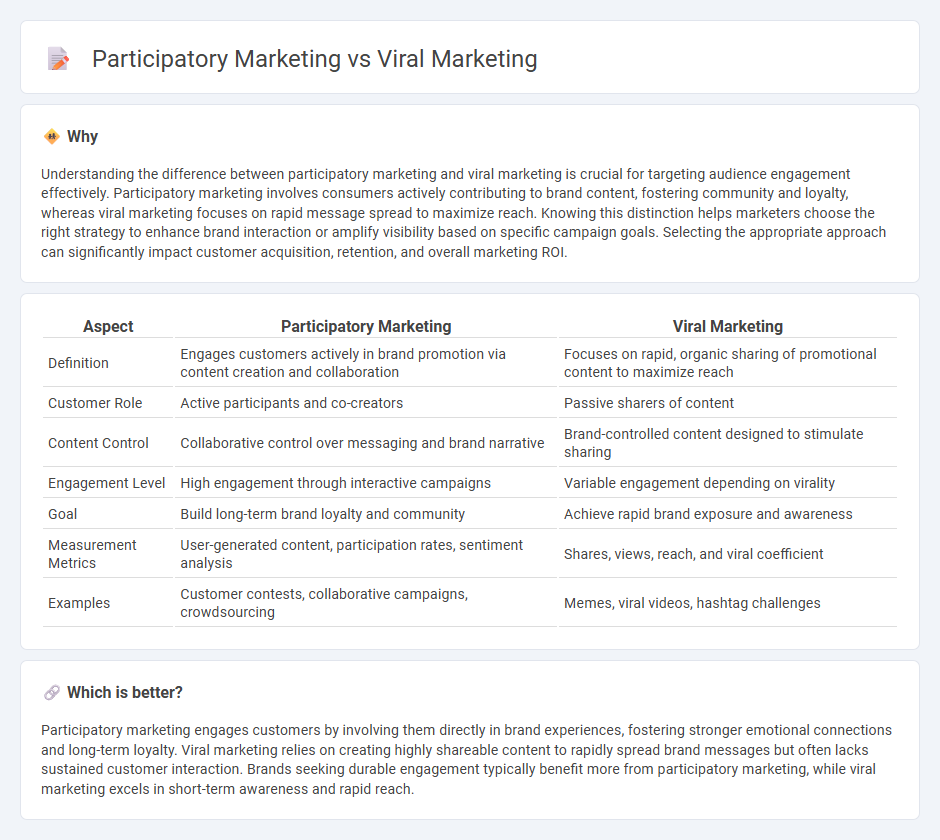
Participatory marketing engages consumers directly by involving them in the creation and promotion of content, fostering brand loyalty and personalized experiences. Viral marketing focuses on creating highly shareable content designed to rapidly spread across social networks, maximizing reach and brand visibility. Explore the nuances between these strategies to enhance your marketing effectiveness.
Why it is important
Understanding the difference between participatory marketing and viral marketing is crucial for targeting audience engagement effectively. Participatory marketing involves consumers actively contributing to brand content, fostering community and loyalty, whereas viral marketing focuses on rapid message spread to maximize reach. Knowing this distinction helps marketers choose the right strategy to enhance brand interaction or amplify visibility based on specific campaign goals. Selecting the appropriate approach can significantly impact customer acquisition, retention, and overall marketing ROI.
Comparison Table
| Aspect | Participatory Marketing | Viral Marketing |
|---|---|---|
| Definition | Engages customers actively in brand promotion via content creation and collaboration | Focuses on rapid, organic sharing of promotional content to maximize reach |
| Customer Role | Active participants and co-creators | Passive sharers of content |
| Content Control | Collaborative control over messaging and brand narrative | Brand-controlled content designed to stimulate sharing |
| Engagement Level | High engagement through interactive campaigns | Variable engagement depending on virality |
| Goal | Build long-term brand loyalty and community | Achieve rapid brand exposure and awareness |
| Measurement Metrics | User-generated content, participation rates, sentiment analysis | Shares, views, reach, and viral coefficient |
| Examples | Customer contests, collaborative campaigns, crowdsourcing | Memes, viral videos, hashtag challenges |
Which is better?
Participatory marketing engages customers by involving them directly in brand experiences, fostering stronger emotional connections and long-term loyalty. Viral marketing relies on creating highly shareable content to rapidly spread brand messages but often lacks sustained customer interaction. Brands seeking durable engagement typically benefit more from participatory marketing, while viral marketing excels in short-term awareness and rapid reach.
Connection
Participatory marketing engages consumers by encouraging active involvement in brand promotion, which amplifies the reach and impact of viral marketing campaigns. Viral marketing depends on user-generated content and sharing behaviors that participatory marketing fosters, creating a feedback loop that enhances brand visibility and authenticity. Together, these strategies leverage social networks and digital platforms to rapidly disseminate marketing messages and deepen consumer engagement.
Key Terms
**Viral Marketing:**
Viral marketing leverages compelling content designed to rapidly spread across social media platforms, engaging millions through shares, likes, and comments, thereby amplifying brand visibility with minimal advertising costs. Campaigns such as the ALS Ice Bucket Challenge demonstrate how user-generated content can exponentially increase reach and foster emotional connections with audiences. Explore the dynamics of viral marketing strategies to maximize your brand's online impact.
Word-of-mouth
Viral marketing leverages rapid, widespread sharing of branded content to maximize word-of-mouth exposure, often through emotionally compelling or entertaining messages. Participatory marketing engages consumers as active contributors, fostering deeper brand involvement and authentic peer-to-peer recommendations. Explore how these strategies uniquely amplify word-of-mouth impact in modern digital campaigns.
Network effects
Viral marketing leverages rapid content sharing to create exponential network effects through user-to-user dissemination, resulting in accelerated brand awareness and engagement. Participatory marketing emphasizes active consumer involvement, fostering community and co-creation that amplify network effects via meaningful interactions and sustained participation. Discover how these strategies uniquely harness network dynamics to maximize marketing impact.
Source and External Links
Viral Marketing: What it is and how it works + Examples - Viral marketing is a communication strategy designed to make content spread quickly and organically among users, leveraging creativity and emotional impact to achieve massive reach with minimal advertising investment, relying on active audience participation and social sharing rather than traditional paid ads.
Viral marketing - This business strategy uses existing social networks to promote products primarily through social media, where consumers share content similarly to how a virus spreads, often transmitted via videos, games, emails, or social posts, aiming to engage individuals with high social networking potential to amplify the message rapidly.
How to Use Viral Marketing To Get Consumers' Attention - Viral marketing involves creating content, typically videos, designed to spread quickly through social sharing and word of mouth, focusing on organic reach within a target audience rather than paid advertising, with success measured by significant increases in shares, likes, and engagement metrics.
 dowidth.com
dowidth.com